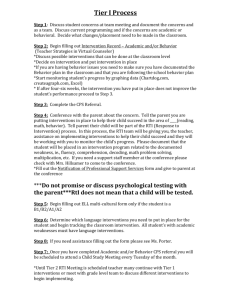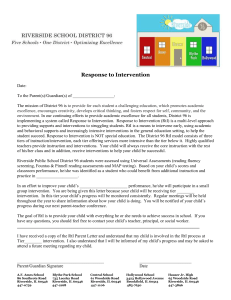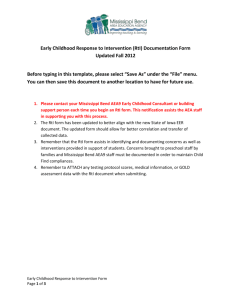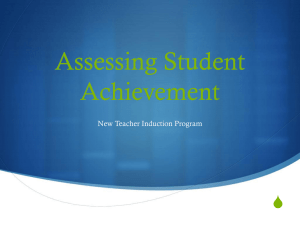Who are the students that should be identified as needing RTI?
advertisement
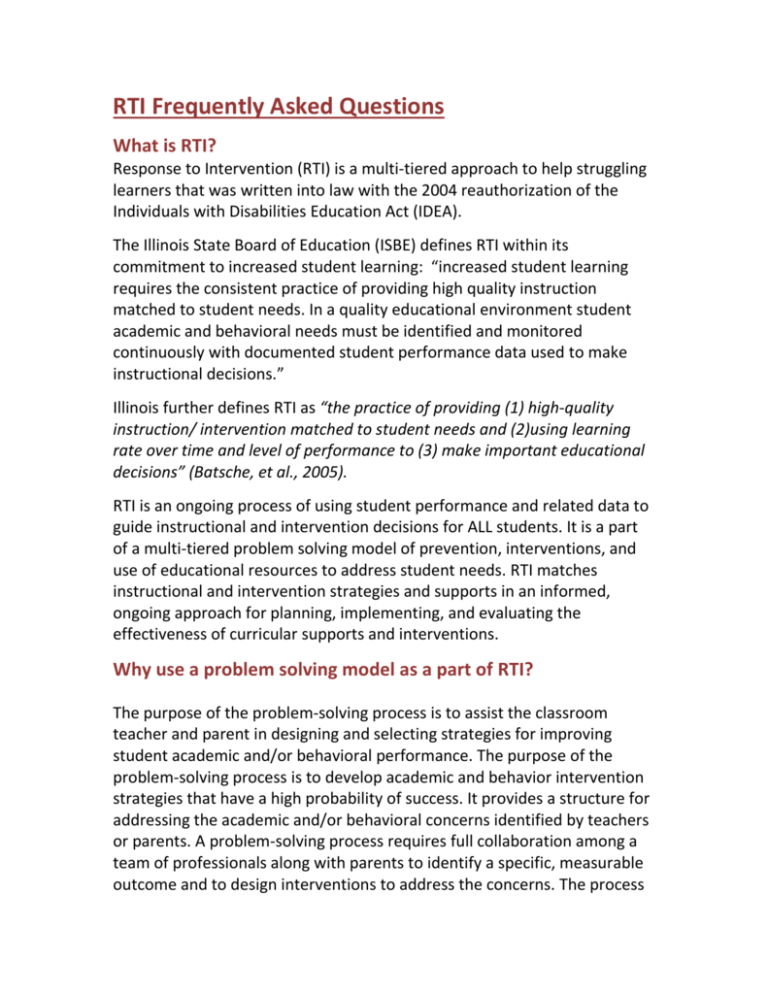
RTI Frequently Asked Questions What is RTI? Response to Intervention (RTI) is a multi-tiered approach to help struggling learners that was written into law with the 2004 reauthorization of the Individuals with Disabilities Education Act (IDEA). The Illinois State Board of Education (ISBE) defines RTI within its commitment to increased student learning: “increased student learning requires the consistent practice of providing high quality instruction matched to student needs. In a quality educational environment student academic and behavioral needs must be identified and monitored continuously with documented student performance data used to make instructional decisions.” Illinois further defines RTI as “the practice of providing (1) high-quality instruction/ intervention matched to student needs and (2)using learning rate over time and level of performance to (3) make important educational decisions” (Batsche, et al., 2005). RTI is an ongoing process of using student performance and related data to guide instructional and intervention decisions for ALL students. It is a part of a multi-tiered problem solving model of prevention, interventions, and use of educational resources to address student needs. RTI matches instructional and intervention strategies and supports in an informed, ongoing approach for planning, implementing, and evaluating the effectiveness of curricular supports and interventions. Why use a problem solving model as a part of RTI? The purpose of the problem-solving process is to assist the classroom teacher and parent in designing and selecting strategies for improving student academic and/or behavioral performance. The purpose of the problem-solving process is to develop academic and behavior intervention strategies that have a high probability of success. It provides a structure for addressing the academic and/or behavioral concerns identified by teachers or parents. A problem-solving process requires full collaboration among a team of professionals along with parents to identify a specific, measurable outcome and to design interventions to address the concerns. The process includes ensuring interventions are implemented with fidelity and student progress is monitored to determine the student’s response. The system must integrate the use of data, both to guide the development of effective interventions and to provide frequent monitoring of progress. How long might a child be in the problem-solving process? The length of time a child participates in the problem solving process depends on the significance of the gap between the student and peers as well as the skill deficits a student has. For example, if a student in 8th grade needs an intervention in math calculations to gain the skills necessary to succeed with Algebra, there may be a need for several specific skill interventions to close the gap with peers. Data may demonstrate that the gap is closing, but the length of time to close the gap may be lengthy. On the other hand, a student who is in 1st grade and needs an intervention addressing directionality at the word level may need a limited Tier II or III intervention in addition to his/her core classroom instruction. Once the skill is gained the gap is closed with peers and the student can continue to progress within the core classroom curriculum alone. This student’s length of participation in the problem-solving process would be limited. Who are the students that should be identified as needing RTI? The students that need to be considered for the RTI process are those students who are not making expected growth as compared to their same age peers despite instruction that has been effective for most of that student’s same age peers. Many researchers refer to these students’ growth as “unexpected underachievement.” When we as educators see this “unexpected underachievement” we need to look further into why this is happening using a problem-solving model. How long should interventions continue in an RTI Model? The amount of time necessary to identify the effectiveness of interventions will vary by skill and the age/grade level of the student. Interventions should be continued as long as the student exhibits a positive response. The interventions should be modified as appropriate when a student’s progress is less than expected. A plan for fading the intervention’s supports should also be put in place once the student begins approaching benchmark. At this point teachers need to start thinking about how to support the student to use the techniques he/she has been taught in small group in the classroom independently. Students need to be able to transfer the work they are doing during intervention times to the classroom. Teachers must remember that the goal for the student is always independence in his/her general education classroom. Is a student ever involved in more than one intervention at a time? Students should typically participate in one intervention at a time for individual skill deficits. For example, if a student has a deficit in reading, a single problem should be determined and a single intervention should be developed to address the identified problem. However, in some situations a student may be participating in a classroom intervention such as a guided reading group to address reading skills in general, but may also be in a more intense guided reading intervention that addresses their needs even more specifically. Additionally, a student may participate in more than one intervention if there are a variety of skill deficits in different academic or behavior areas. For example, a student may be receiving a behavior intervention and a reading intervention at the same time or a reading intervention and a math intervention at the same time. What is the criterion for a successful intervention? An intervention is successful if the achievement gap between the performance of the student at-risk and the expected benchmark has decreased based on the data collected through progress monitoring. Problem solving teams should collect multiple points of data to determine whether the gap has closed or is closing. Who provides the interventions? A variety of people may provide interventions in the problem-solving process. In Tier I, classroom teachers should be the primary provider of interventions and strategies. At the Tier II & III level, classroom teachers, literacy coaches, reading teachers, special education teachers, school psychologists, school social workers, etc. can provide interventions. The interventionist should be selected based on intensity of intervention, skill level of interventionist, and training required to deliver the intervention. What is progress monitoring? Progress monitoring assessments are brief assessments given periodically to determine whether students are making adequate progress. Progress monitoring assessment data should be collected, evaluated, and used on an ongoing basis for the following purposes: Provide information to guide the interventionist’s daily lesson plans Determine rate of a student's progress Provide information on the effectiveness of instruction and to modify the intervention if necessary Identify the need for additional information Analyze and interpret gaps between benchmarks and achievement Who progress monitors or conducts assessments in RTI? Many different individuals can progress monitor depending on the tool being used. Classroom teachers, literacy coaches, reading teachers, special education teachers, school psychologists, and school workers can all progress monitor depending on their training. In many cases it may make sense for the professional delivering the intervention to also assess the student’s progress. This would allow the assessment data to be used as a guide for the next steps in instruction, a formative assessment approach. The classroom teacher should also be continuing to gather assessment data on all the students within his/her classroom toward grade level benchmarks. For our most tangled students having multiple points of data is helpful in determining not only where the student’s gaps are but also how we can best build on the student’s strengths. How do students “move” between Tiers? District 47 has adopted a layering model. This means that students will not be moving between tiers as much as adding on layers of intervention. Students should always be receiving Tier 1 interventions as a part of their classroom instruction. Additional layers will be added and taken away based on the student’s needs and how they respond to the intervention(s) over time. Interventions need to be flexible based on the student’s needs. What does fidelity of an intervention mean? Fidelity of intervention implementation includes two key factors that must align with the intervention’s evidence/research base. The first, integrity, refers to the degree to which an intervention is implemented (taught) as intended. The second factor, sufficiency, refers to the intervention being implemented for an adequate amount of time (minutes per week and overall duration) to achieve desired results. Is RTI just a way to avoid providing special education services? No. RTI is a way to integrate the mandates of No Child Left Behind (NCLB) and IDEA so that all students receive high quality, effective instruction in the general education setting and beyond. Also, RTI is a framework of instruction for students who do receive special education services. The intent is to generate a seamless system of support that is available to all students at the first sign of need. RTI will support students more fully that special education can alone since its focus is on early intervention. With RIT students no longer have to wait to fail in order to get the support they need. What is an intervention and why is it so important? Intervention is the main term we all need to know and understand within RTI. When thinking about intervention think instruction. In her book, RTI from All Sides, Mary Howard suggests that RTI should have been named Response to Instruction instead of Response to Intervention. Really it makes sense-students who are not successful with the instruction occurring in their classrooms require additional instruction to build their skills. The goal is to offer more-more time, more support, and more opportunity. What is an accommodation? Accommodations are not interventions. Accommodations are those supports we provide to help the student access or demonstrate learning. These provisions should not change what the student is expected to learn; just make the learning more accessible and/or evident. For example, reading a math test to a student struggling with reading would be an accommodation. This support would allow a teacher to assess the student’s math skills more clearly. What is a modification? Modifications are not interventions; modifications differ from interventions and accommodations. When modifying we are changing what we expect students to know and learn. When modifying for students we are adding a scaffold that changes the expectation of learning for a particular skill. We are expecting the student to perform to a lesser degree than what the grade level benchmark would require. Typically when modifying for students we want to make sure we have a well documented plan in place for fading away from the reduction in expectation. Remember the goal for students in RTI is to catch up to their same age peers. Typically, we see modification for those students already receiving special services such as ELL or Special Education. Why is common language between classroom teachers and interventionists suggested as a part of intervention planning? Since RTI strives to increase the instructional time students who are struggling receive, most often students receiving interventions see more than one teacher during the day. For these, our most tangled students, we want to make sure that both classroom teachers and intervention specialist are using common language when providing instruction. What research tells us is that our struggling students do not transfer skills well and tend to be less able to make inferences than typical general education students. Therefore, when providing students with the same prompts in the classroom and in intervention groups we help extend their ability to transfer skills from one setting to setting. Our goal with any intervention is to create learning that allows students to be successful in the general education classroom independent of the intervention. Common language between teachers makes it easier for students to achieve this goal. What should we do for students coming out of Reading Recovery as Recommended Action? Guidelines for Recommended Action Students: It is important to take into consideration the fact that Recommended Action students have had a very intensive intervention (20 weeks of one-on-one lessons designed to meet their individual needs). However, the next action to be taken will vary for each child. It will be up to building problem-solving teams to determine what the best course of action will be. Below are some general guidelines that can help guide discussions about the Recommended Action children: Given the fact that Reading Recovery is meant to be a short-term intervention, it is not possible to continue teaching these children in a one-to-one situation. The average time in a Reading Recovery intervention ranges from 12 to 15 weeks, and a recommended upper limit has been set at 20 weeks. All children who end the Reading Recovery intervention with a Recommended Action status need to continue in a reading intervention. What that intervention will look like will depend on the level that the child tested out at the end of the Reading Recovery intervention. The levels below can provide RTI team-leaders with a frame of reference for discussion purposes, but remember that the Reading Recovery teacher who taught the student has the most information about the student as a literacy learner. The Reading Recovery teacher must be included at this point in the process. Levels 1-6 These children have demonstrated very little progress in the 20 weeks of their intense intervention. A special education teacher should be present at the problem-solving meeting since clearly these students will need some individualized programming to help them grow as readers. When planning an intervention for these children, take intensity and frequency into consideration. Levels 7-10 These children have made progress, but are not quite at grade-level standards. A Guided Reading Plus group should be an appropriate intervention for these students. Close monitoring of growth toward the benchmark should occur for these children. Levels 10-12 These children are ending their interventions just below grade-level standards. A Guided Reading Plus group will be appropriate for these students. When should problem-solving teams begin to bring in other specialists, i.e. teachers who support second language learners, special education support professionals, building literacy coaches, district personal? If the student has, has had in the past, or is suspected of having second language needs an ELL/Bilingual/ or Dual Language Teacher should always be present at the RTI problem-solving meeting. A special education support professional can be invited to the RTI problemsolving meetings anytime the team feels they need these professionals’ help in problem-solving for the student. Any support person should always be consulted prior to being added as a to a student’s intervention plan to either provide direct intervention services and/or before being assigned to test a student. When should RTI teams begin considering special education for a student in the problem solving process? The student’s RTI problem-solving team should start by inviting the special education professional(s) to their RTI problem-solving meeting where the student’s goals are being reviewed. As a whole team these professionals can then decide where to go next with this student’s problem-solving and intervention planning. For struggling ELL students is it better to keep instruction limited to English alone? Does managing two languages confuse these students? At one time in our history it was believed that managing two languages caused confusion of students; however, now research clearly tells us that this is not the case. There is a great deal of research now being done across the nation that supports the practice of providing instruction in both English and the student’s home language. Research tells us that both languages actually support student learning when used together. When should we contact our district’s bilingual social worker and/or bilingual school psychologist? You can contact them at any time in the problem-solving process. Earlier on in the process is usually better than later, but it is up to each team to decide when to bring them into the process. You can reach them through email, Effie Cambes (SSW) and Marisa Vasquez (School Psychologist). Remember: Your building ELL person should always be included in meetings concerning ELL students.

